Abstract
Methane consumption by forest soil was studied in situ and in vitro with respect to responses to nitrogen additions at atmospheric and elevated methane concentrations. Methane concentrations in intact soil decreased continuously from atmospheric levels at the surface to 0.5 ppm at a depth of 14 cm. The consumption rate of atmospheric methane in soils, however, was highest in the 4- to 8-cm depth interval (2.9 nmol per g of dry soil per day), with much lower activities below and above this zone. In contrast, extractable ammonium and nitrate concentrations were highest in the surface layer (0 to 2 cm; 22 and 1.6 μmol per g of dry soil, respectively), as was potential ammonium-oxidizing activity (19 nmol per g of dry soil per day). The difference in zonation between ammonium oxidation and methane consumption suggested that ammonia-oxidizing bacteria did not contribute significantly to atmospheric methane consumption. Exogenous ammonium inhibited methane consumption in situ and in vitro, but the pattern of inhibition did not conform to expectations based on simple competition between ammonia and methane for methane monooxygenase. The extent of ammonium inhibition increased with increasing methane concentration. Inhibition by a single ammonium addition remained constant over a period of 39 days. In addition, nitrite, the end product of methanotrophic ammonia oxidation, was a more effective inhibitor of methane consumption than ammonium. Factors that stimulated ammonium oxidation in soil, e.g., elevated methane concentrations and the availability of cosubstrates such as formate, methanol, or β-hydroxybutyrate, enhanced ammonium inhibition of methane oxidation, probably as a result of enhanced nitrite production.
Full text
PDF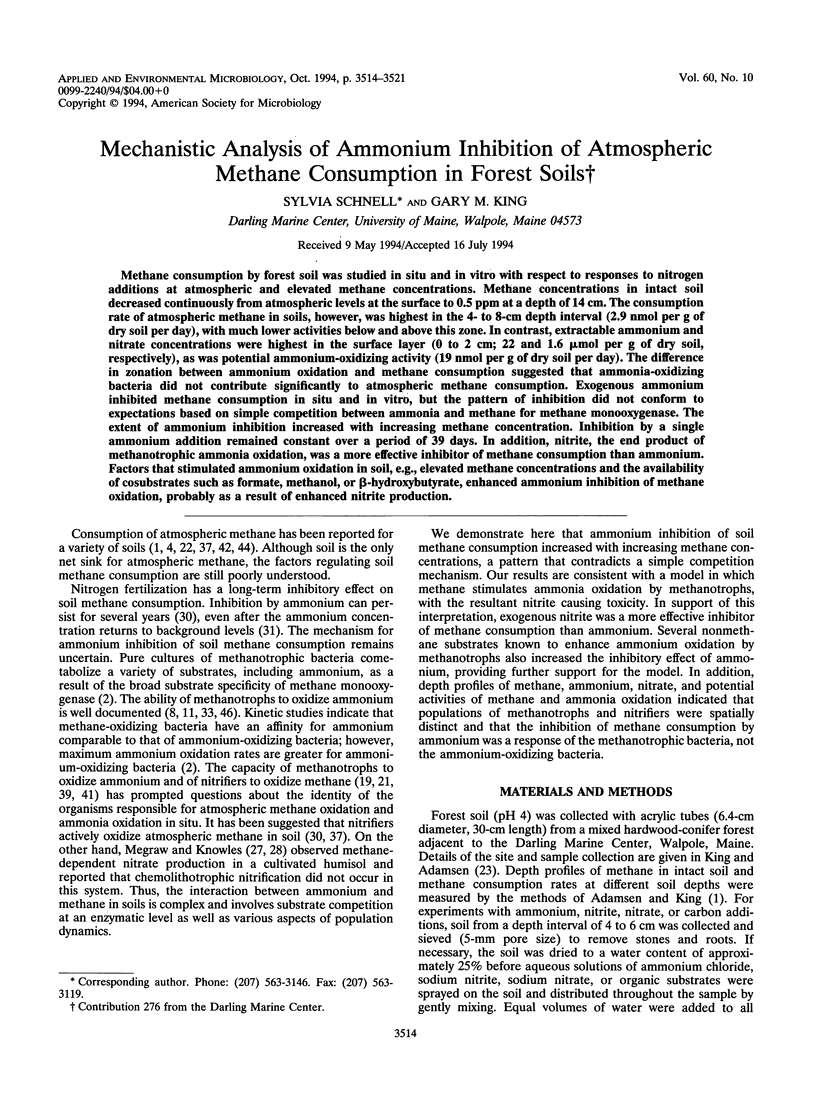
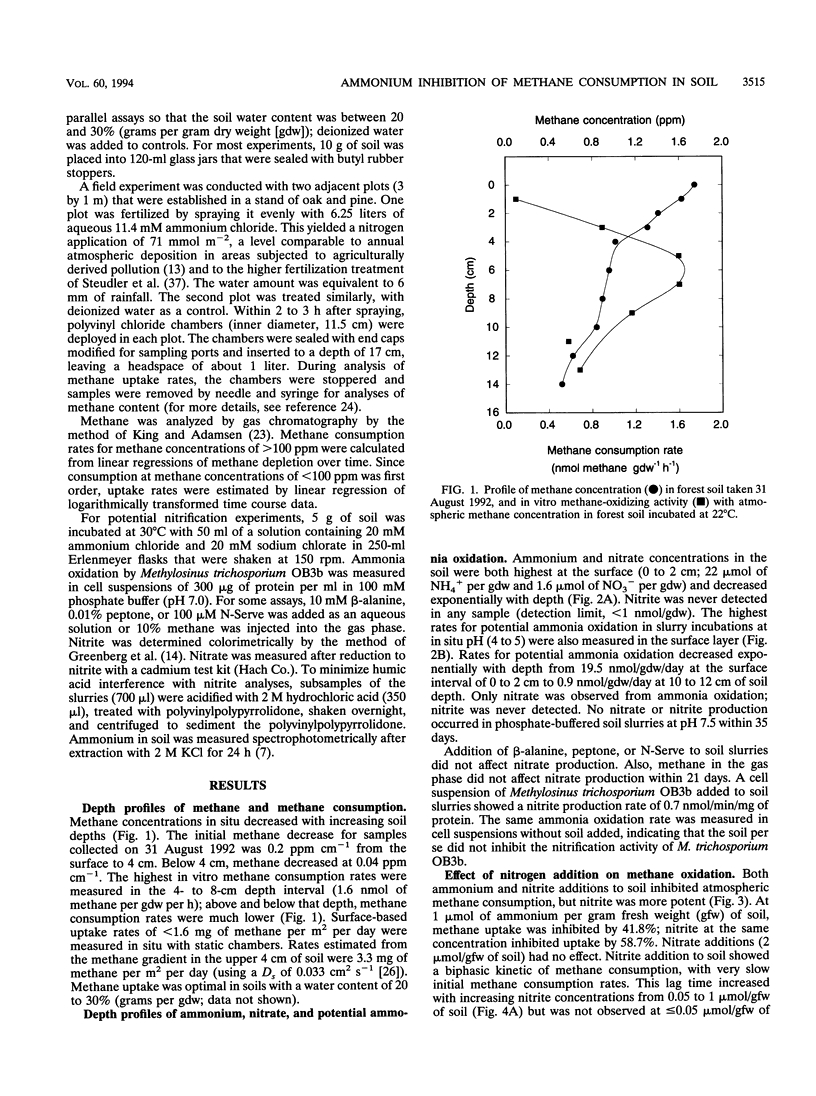



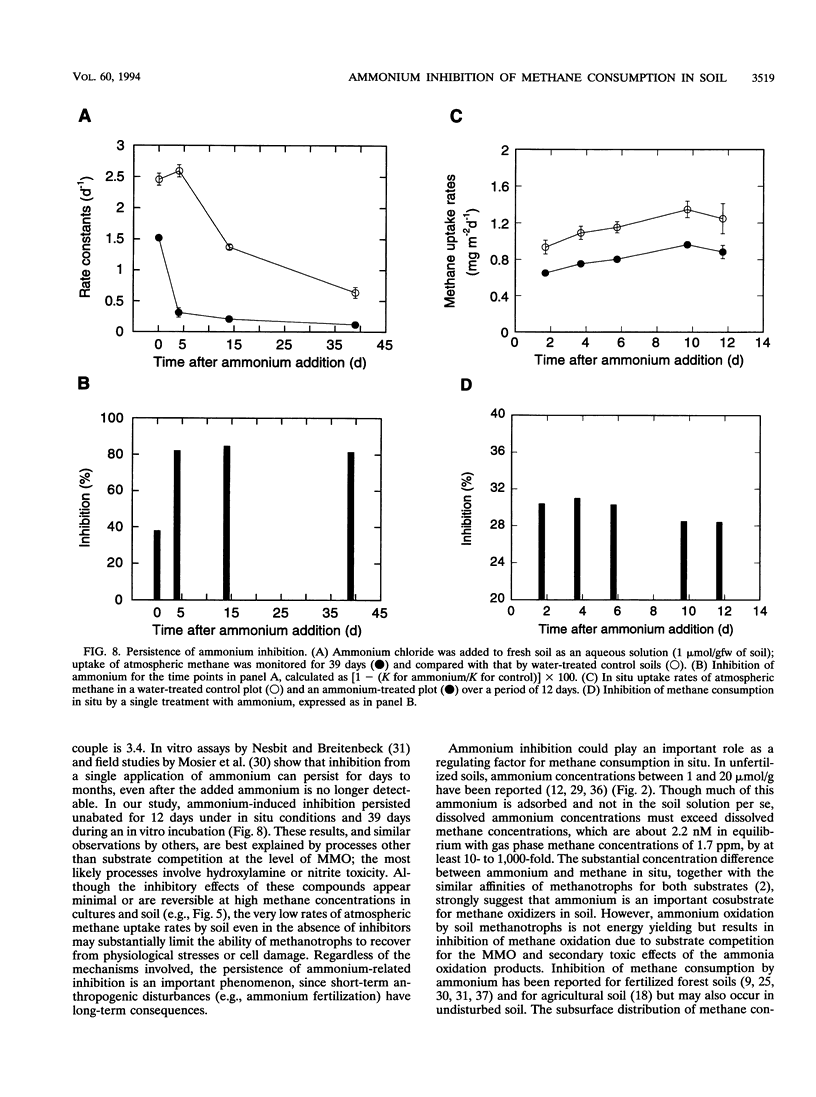
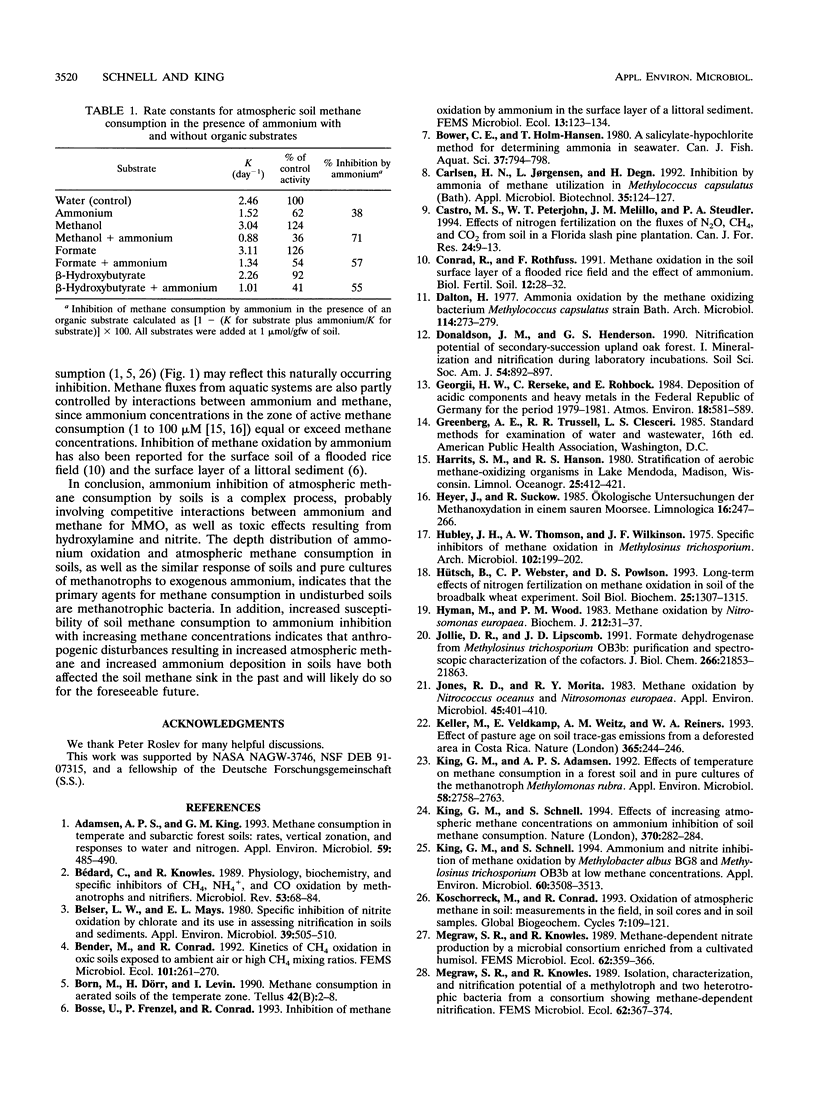
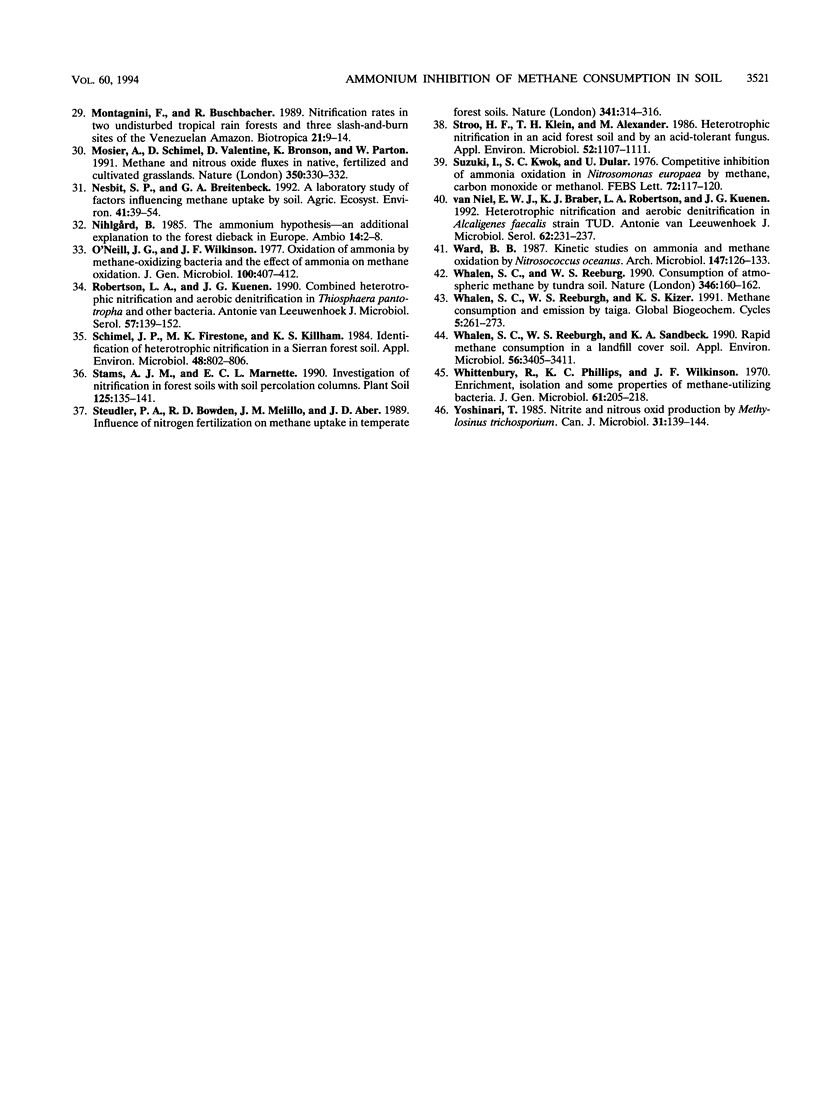
Selected References
These references are in PubMed. This may not be the complete list of references from this article.
- Adamsen A. P., King G. M. Methane consumption in temperate and subarctic forest soils: rates, vertical zonation, and responses to water and nitrogen. Appl Environ Microbiol. 1993 Feb;59(2):485–490. doi: 10.1128/aem.59.2.485-490.1993. [DOI] [PMC free article] [PubMed] [Google Scholar]
- Belser L. W., Mays E. L. Specific inhibition of nitrite oxidation by chlorate and its use in assessing nitrification in soils and sediments. Appl Environ Microbiol. 1980 Mar;39(3):505–510. doi: 10.1128/aem.39.3.505-510.1980. [DOI] [PMC free article] [PubMed] [Google Scholar]
- Bédard C., Knowles R. Physiology, biochemistry, and specific inhibitors of CH4, NH4+, and CO oxidation by methanotrophs and nitrifiers. Microbiol Rev. 1989 Mar;53(1):68–84. doi: 10.1128/mr.53.1.68-84.1989. [DOI] [PMC free article] [PubMed] [Google Scholar]
- Hyman M. R., Wood P. M. Methane oxidation by Nitrosomonas europaea. Biochem J. 1983 Apr 15;212(1):31–37. doi: 10.1042/bj2120031. [DOI] [PMC free article] [PubMed] [Google Scholar]
- Jollie D. R., Lipscomb J. D. Formate dehydrogenase from Methylosinus trichosporium OB3b. Purification and spectroscopic characterization of the cofactors. J Biol Chem. 1991 Nov 15;266(32):21853–21863. [PubMed] [Google Scholar]
- Jones R. D., Morita R. Y. Methane Oxidation by Nitrosococcus oceanus and Nitrosomonas europaea. Appl Environ Microbiol. 1983 Feb;45(2):401–410. doi: 10.1128/aem.45.2.401-410.1983. [DOI] [PMC free article] [PubMed] [Google Scholar]
- King G. M., Adamsen A. P. Effects of Temperature on Methane Consumption in a Forest Soil and in Pure Cultures of the Methanotroph Methylomonas rubra. Appl Environ Microbiol. 1992 Sep;58(9):2758–2763. doi: 10.1128/aem.58.9.2758-2763.1992. [DOI] [PMC free article] [PubMed] [Google Scholar]
- King G. M., Schnell S. Ammonium and Nitrite Inhibition of Methane Oxidation by Methylobacter albus BG8 and Methylosinus trichosporium OB3b at Low Methane Concentrations. Appl Environ Microbiol. 1994 Oct;60(10):3508–3513. doi: 10.1128/aem.60.10.3508-3513.1994. [DOI] [PMC free article] [PubMed] [Google Scholar]
- Robertson L. A., Kuenen J. G. Combined heterotrophic nitrification and aerobic denitrification in Thiosphaera pantotropha and other bacteria. Antonie Van Leeuwenhoek. 1990 Apr;57(3):139–152. doi: 10.1007/BF00403948. [DOI] [PubMed] [Google Scholar]
- Schimel J. P., Firestone M. K., Killham K. S. Identification of heterotrophic nitrification in a sierran forest soil. Appl Environ Microbiol. 1984 Oct;48(4):802–806. doi: 10.1128/aem.48.4.802-806.1984. [DOI] [PMC free article] [PubMed] [Google Scholar]
- Stroo H. F., Klein T. M., Alexander M. Heterotrophic nitrification in an Acid forest soil and by an Acid-tolerant fungus. Appl Environ Microbiol. 1986 Nov;52(5):1107–1111. doi: 10.1128/aem.52.5.1107-1111.1986. [DOI] [PMC free article] [PubMed] [Google Scholar]
- Suzuki I., Kwok S. C., Dular U. Competitive inhibition of ammonia oxidation in Nitrosomonas europaea by methane, carbon monoxide or methanol. FEBS Lett. 1976 Dec 15;72(1):117–120. doi: 10.1016/0014-5793(76)80825-3. [DOI] [PubMed] [Google Scholar]
- Whalen S. C., Reeburgh W. S., Sandbeck K. A. Rapid methane oxidation in a landfill cover soil. Appl Environ Microbiol. 1990 Nov;56(11):3405–3411. doi: 10.1128/aem.56.11.3405-3411.1990. [DOI] [PMC free article] [PubMed] [Google Scholar]
- Whittenbury R., Phillips K. C., Wilkinson J. F. Enrichment, isolation and some properties of methane-utilizing bacteria. J Gen Microbiol. 1970 May;61(2):205–218. doi: 10.1099/00221287-61-2-205. [DOI] [PubMed] [Google Scholar]
- Yoshinari T. Nitrite and nitrous oxide production by Methylosinus trichosporium. Can J Microbiol. 1985 Feb;31(2):139–144. doi: 10.1139/m85-027. [DOI] [PubMed] [Google Scholar]
- van Niel E. W., Braber K. J., Robertson L. A., Kuenen J. G. Heterotrophic nitrification and aerobic denitrification in Alcaligenes faecalis strain TUD. Antonie Van Leeuwenhoek. 1992 Oct;62(3):231–237. doi: 10.1007/BF00582584. [DOI] [PubMed] [Google Scholar]


